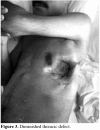Negative pressure wound closure system for giant thoracic defect closure in a patient with completely visible pericardium: A case report
- PMID: 32082815
- PMCID: PMC7018174
- DOI: 10.5606/tgkdc.dergisi.2018.15703
Negative pressure wound closure system for giant thoracic defect closure in a patient with completely visible pericardium: A case report
Abstract
Negative pressure wound closure system facilitates wound closure via wound contraction. In this article, we report a successful application of thoracic negative pressure wound closure system to fill the thoracic defect, control infection, and expand the lung in a 35-year-old male patient with threerib defect, lung parenchyma injury, empyema, left complete pneumothorax, and visible pericardium after gunshot injury. The excellent result obtained in our patient demonstrates that negative pressure wound closure system is a good choice for treating high-energy thoracic injuries by reducing wound infection and enabling early wound closure.
Keywords: Negative pressure wound therapies; vacuum assisted closure; wound care.
Copyright © 2018, Turkish Society of Cardiovascular Surgery.
Conflict of interest statement
Conflict of Interest: The authors declared no conflicts of interest with respect to the authorship and/or publication of this article.
Figures
Similar articles
-
Right Ventricular Perforation From a Floating Rib Following Deep Sternal Wound Infection Debridement and Application of a Vacuum-Assisted Closure Device: A Case Report and Literature Review.Eplasty. 2017 Apr 6;17:e15. eCollection 2017. Eplasty. 2017. PMID: 28458765 Free PMC article.
-
Vacuum-assisted closure: a new method for treating patients with giant omphalocele.J Pediatr Surg. 2006 Jan;41(1):212-5. doi: 10.1016/j.jpedsurg.2005.10.003. J Pediatr Surg. 2006. PMID: 16410135
-
Blood flow responses in the peristernal thoracic wall during vacuum-assisted closure therapy.Ann Thorac Surg. 2005 May;79(5):1724-30; discussion 1730-1. doi: 10.1016/j.athoracsur.2004.10.053. Ann Thorac Surg. 2005. PMID: 15854963
-
[Intrathoracic Vacuum-Assisted Closure in the Treatment of Pleural Empyema and Lung Abscess].Zentralbl Chir. 2015 Jun;140(3):321-7. doi: 10.1055/s-0034-1383273. Epub 2015 Apr 23. Zentralbl Chir. 2015. PMID: 25906022 Review. German.
-
Surgical views: Vacuum-assisted wound closure: application and mechanism of action.Compend Contin Educ Vet. 2009 Dec;31(12):E1-5, E7; quiz E6. Compend Contin Educ Vet. 2009. PMID: 20180227 Review.
References
-
- Argenta LC, Morykwas MJ. Vacuum-assisted closure: a new method for wound control and treatment: clinical experience. Ann Plast Surg. 1997;38:563–576. - PubMed
-
- Demir A, Demirtaş Y, Ciftci M, Öztürk N, Karacalar A. Topical negative pressure vacuum assisted closure (VAC) applications. Türk Plast Rekonstr Est Cer Derg. 2006;14:171–177.
-
- Ozturk E, Ozguc H, Yilmazlar T. The use of vacuum assisted closure therapy in the management of Fournier's gangrene. Am J Surg. 2009;197:660–665. - PubMed
-
- Simsek A, Ozer MT, Eryilmaz M, Ozturk E, Ozerhan IH, Gorgulu S, et al. The results of damage control surgery in abdominal trauma. Balkan Military Medical Review. 2007;10:136–140.
Publication types
LinkOut - more resources
Full Text Sources





